Minimizing Alpha Case During Vacuum Heat Treating Titanium
Minimizing Alpha Case During Vacuum Heat Treating Titanium
Understanding detrimental alpha case formation during heat treatment of titanium parts is increasingly important as titanium use in aerospace and medical applications continues to grow.
Alpha case is a diffusion reaction that occurs at the surface of titanium when processing at elevated temperature in atmospheres containing oxygen, nitrogen, and/or carbon, with oxygen the prominent element associated with alpha case. Oxygen is solution strengthening at low concentrations, but greatly decreases ductility and forms alpha case at higher concentrations. Thus, alpha case is brittle and has a detrimental effect on part performance and longevity. Higher temperatures increase alpha case. Above 480°C (896°F), air or water vapor will start to produce alpha case. Temperatures less than 550°C (1022°F) limit oxygen mobility and keep the case depth from increasing. (Donachie, 2000)
To minimize alpha case, high integrity titanium parts are often heat treated in vacuum furnaces to avoid having to remove the case by machining or pickling. The majority of today’s production vacuum furnaces are insulated with graphite felt. At lower temperatures in vacuum, water vapor is the principal concern for oxidizing titanium when H2O dissociates. It is known in industry that water vapor is difficult to “pump out” at low temperature in vacuum. As the temperature increases water vapor present in the vacuum chamber will be “driven out,” oxidizing titanium on the ramp-up to the cycle hold temperature. At higher temperatures water vapor decreases while CO2 and CO increase, providing additional sources for alpha case formation. (Jones, 2014) In an attempt to minimize oxidation, industry slows the ramp rate down and incorporates temperature holds if outgassing exceeds a certain pressure. (Jordan, 2008) Sound practice requires an initial pumpdown to 1 x 10-4 Torr or lower (AMS2769 specification) and relatively slow ramp at 600°F/hr.; if outgassing occurs, hold until the pressure drops to 2 x 10-4 Torr. Such procedures negatively affect production time. The current study looks at whether such protocols are reliably effective in reducing alpha case formation.
Color has been used as a post-welding and heat treatment criterion for the presence of alpha case. This study examined whether there was any correlation between color and extent of alpha case.
After polishing and etching, alpha case is visible under a microscope as a white-appearing microstructure zone, or alpha phase. Literature lists three principal etchants for revealing titanium alpha case: Kroll’s reagent, 2% HF, and Kroll’s reagent followed immediately by 2% ammonium bifluoride. Etchant dwell time is an important variable in obtaining reliable results.
Procedure for Minimizing Alpha Case During Vacuum Heat Treating Titanium
Ti-6Al-4V sheet was cut into thirteen coupons approximately 1.5 inches square. Twelve samples were divided into six pairs for use in six separate heat treat cycles. The thirteenth sample was retained as the un-heat treated baseline (virgin) for metallographic analysis. Additional titanium sheet was used in test #5 to increase surface area by a factor of nine compared to the other five tests.
The furnace used for all tests was a cylindrical, vertical vacuum furnace, 10” diameter x 18” high, with graphite felt insulation and graphite heating elements. An Ametek residual gas analyzer (RGA) was attached to the furnace. The RGA captures a sample of the residual gases in the furnace hot zone to provide a trend analysis of the relative gas composition and pressure during the cycle.
Two ramp rates, one relatively slow and the other fast, and two hold temperatures were used for five test cycles. All cycles began after an initial pumpdown to 1 x 10-4 torr. The one-step fast ramp rate was 1200°F/hr to the hold temperature. The two-step slow ramp rate was 300°F/hr to 900°F, then 600°F/hr to the hold temperature. The two hold temperatures were 1450°F and 1750°F with a one-hour hold time. The sixth test cycle used a three-step ramp rate as follows: 300°F/hr to 600°F, one hour hold; 300°F/hr to 900°F, one hour hold; 600°F/hr to 1450°F, one hour hold.
Two coupons were hung on separate molybdenum wires attached to the lid of the furnace for each cycle. One coupon was intended to be color analyzed using a HunterLab spectrophotometer. The second coupon was used for metallographic analysis of alpha case. Specimens were etched using either Kroll’s reagent, 2% HF, or Kroll’s followed immediately by 2% ammonium bifluoride. Comparisons were made as to which etchant best delineated alpha case along with the effect of dwell time.
Minimizing Alpha Case During Vacuum Heat Treating Titanium Results and Discussion:
The appearance of coupons from all tests revealed color was not a distinguishing material attribute, Figure 1. It is more accurate to say that the samples varied in reflectivity more than in color. As a result, the spectrophotometer was not useful for its intended function. However, differences in reflectivity proved meaningful, showing that bright-appearing samples can exhibit more alpha case than non-bright samples. Figure 1 summarizes the results. The two coupons heated to 1450°F show a yellowish tint. The two coupons heated to 1750°F are matte gray. The coupon of cycle 5 appears as bright as the virgin piece. Based on appearance, the sample from cycle 5 might suggest that there is no alpha case. However, test piece 5 had considerably more alpha case than the yellow tinted samples from Tests 2 and 4.
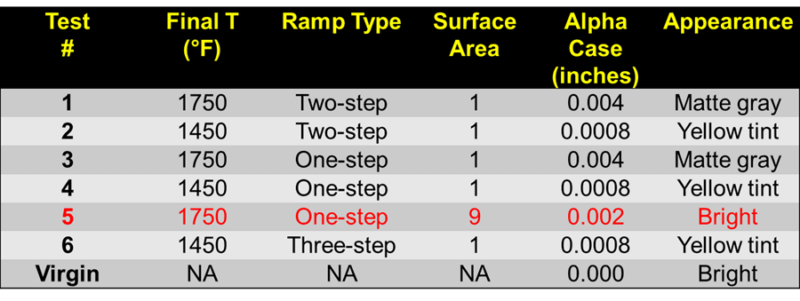
RGA data revealed that water vapor is the primary oxidizing residual gas resulting in alpha case. As temperature rises, the partial pressure of carbon monoxide and carbon dioxide increase to contribute to alpha case formation. Yet ultimately, the trends show a continuous decrease in partial pressure of furnace gases owing to the strong gettering effect of titanium, Figure 2.
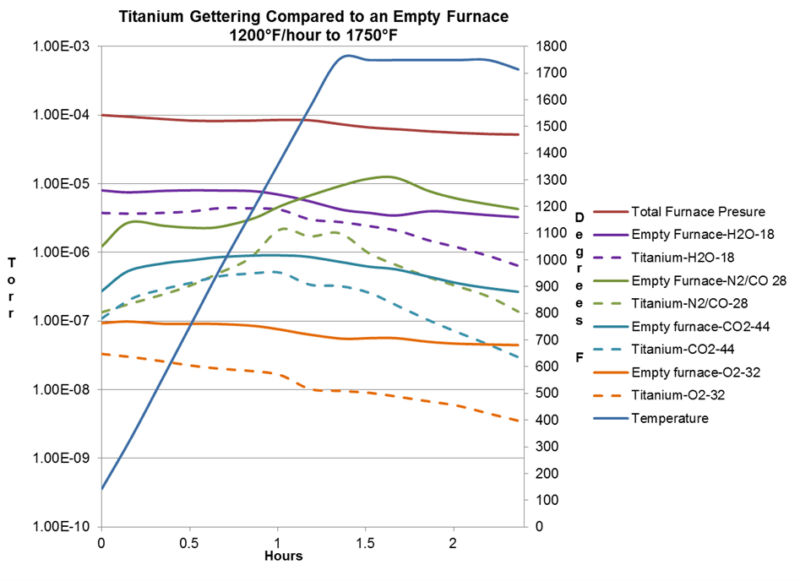
Metallographic results show that visual inspection cannot reliably be used as an indication of alpha case. Varying the ramp rate or incorporating intermittent temperature holds did not affect the amount of alpha case formed in the low temperature cycles (Figure 3) or high temperature cycles (Figure 4). Comparison of cycles 3 and 5, which were one-step fast ramps to 1750°F, shows that increased surface area reduces the amount of alpha case formation, Figure 5.
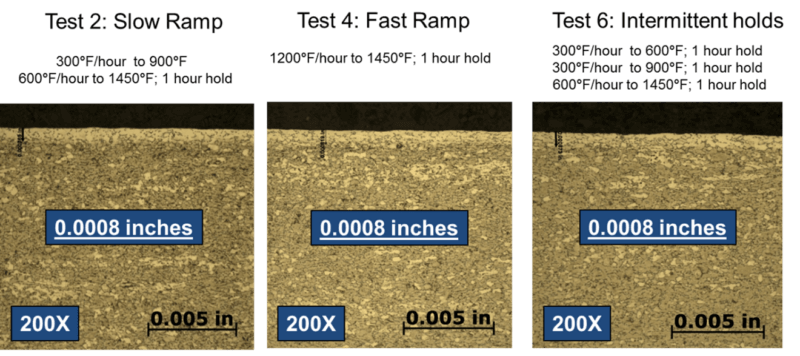
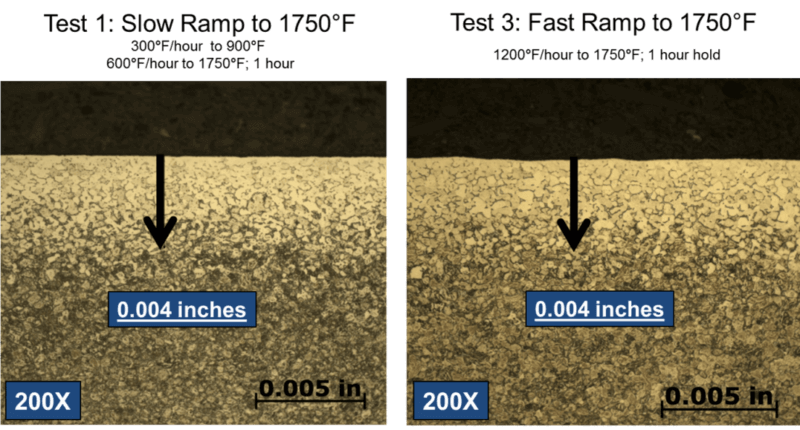
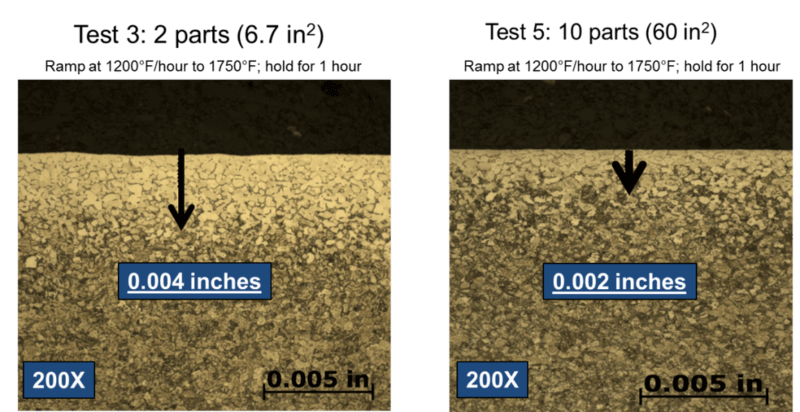
Evaluation of three different metallographic etchants indicated that 2% HF best distinguished the delineation between alpha case and base metal, Figure 6. However, etching time is all-important in generating an accurate reading regardless of which etchant is used. Etchant times between six and ten seconds using 2% HF delineated comparable alpha case when etched immediately after polishing. Etching times longer than ten seconds caused the case to appear shallower in depth, Figure 7.

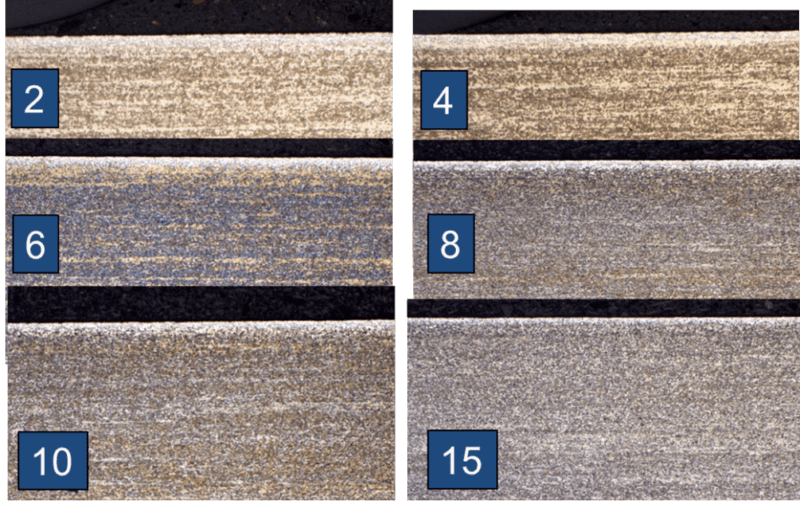
Minimizing Alpha Case During Vacuum Heat Treating Titanium Conclusions:
The surface color or reflectivity of titanium after heat treatment is independent of the underlying alpha case. Varying ramp rates or instituting intermediate temperature holds during outgassing did not minimize the formation of alpha case, owing to the strong “gettering effect” of titanium as revealed by the RGA. Temperature, time, surface area, and furnace cleanliness all contribute to the extent of alpha case formation.
RGA data reveals that water vapor is the primary oxidizing residual gas. As temperature increases, carbon monoxide and carbon dioxide contribute to alpha case formation in a graphite-insulated vacuum furnace. Introduction of sacrificial “gettering surface area” decreased the amount of alpha case on any given test coupon. Thus, it is most beneficial to process as many parts (surface area) as feasible in a heat treatment load. Ramping directly to the hold temperature is beneficial to production efficiency.
Metallographic comparisons of three etchants indicate that etchant type and dwell time can considerably influence the observed depth of alpha case.
Authors:


References:
- Donachie, Matthew J.; Titanium, A Technical Guide, ASM International, 2000; 61-62.
- Jones, Trevor; The Use of a Vacuum Residual Gas Analyzer and its Evaluation Between a Graphite and Molybdenum Insulated Hot Zone; presented at Furnaces North America, Nashville, TN, October 7, 2014.
- Jordan, Don and Antes, Harry; Study of Alpha Case Formation On Heat treated Ti-6-4, Industrial Heating, May/June 2008, 45.

